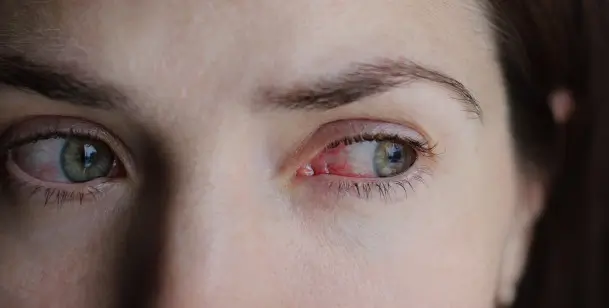When red, itchy, and irritated eyes strike, it’s easy to jump to the conclusion that it’s conjunctivitis (pink eye). However, several other eye conditions share similar symptoms, leading to misidentification and potentially delaying proper treatment. Continue reading to learn about pink eye, what is commonly misdiagnosed as pink eye, and how to properly treat these conditions.
What is Pink Eye?
Pink eye, also known as conjunctivitis, is an infection or inflammation of the conjunctiva, the clear membrane that covers the white part of the eye and lines the inner surface of the eyelids. Pink eye is highly contagious and can spread through direct or indirect contact with infected eye secretions. Prompt diagnosis and appropriate treatment are essential to prevent its spread and manage the symptoms effectively.
Causes & Symptoms of Pink Eye
Pink eye can have various causes and presents with distinct symptoms. Here are the most common causes and symptoms:
Viral
Viral conjunctivitis is commonly caused by viruses like adenovirus and is highly contagious. It often accompanies respiratory infections or the common cold.

Bacterial
Bacterial conjunctivitis is usually caused by bacteria such as Staphylococcus aureus or Streptococcus pneumoniae. It can result from poor hygiene or touching the eyes with dirty hands.
Allergic
Allergic conjunctivitis occurs due to allergens like pollen, pet dander, or dust mites, triggering an immune response in the eye.
Irritants
Exposure to irritating substances like smoke, chemicals, or chlorine in swimming pools can cause non-infectious conjunctivitis.
Common Symptoms of Pink Eye:
Pink eye has a collection of common symptoms, including:
- Redness: The white part of the eye becomes pink or red due to inflammation of the conjunctiva.
- Itching or Burning Sensations: The eyes may feel itchy and irritated, leading to frequent rubbing.
- Tearing: Excessive tearing or watery discharge from the eyes can occur.
- Discharge: In bacterial conjunctivitis, the oil glands of the eyes may produce a thick, yellowish-green discharge, causing crust formation around the eyelids during sleep.
- Sensitivity to Light & Blurry Vision: Known as photophobia, people with pink eye may experience discomfort when exposed to bright lights. Additionally, due to the strain and pus impacting the eye, patients may experience blurred vision.
- Swelling: The eyelids may become puffy and swollen in some cases.

Treatment for Pink Eye
Pink eye treatment will depend on the type of conjunctivitis you are dealing with. See below:
Viral Conjunctivitis
Often resolves on its own. Use warm compresses and artificial tears for relief.
Bacterial Conjunctivitis
Requires antibiotics (eye drops/ointment) prescribed by a doctor.
Allergic Conjunctivitis
Avoid allergens and use OTC antihistamine eye drops.
Irritant-Induced Conjunctivitis
Avoid irritants and use artificial tears.

Preventing Pink Eye
Preventing pink eye (conjunctivitis) involves adopting good hygiene practices and avoiding contact with infected individuals or substances that can cause irritation. Here are some essential preventive habits you can develop:
- Frequent Handwashing
- Avoid Touching Your Eyes
- Avoid Sharing Personal Items
- Following Proper Contact Lens Hygiene
- Avoiding Irritants
- Allergen Management
- Using Hand Sanitizer
- Practicing Proper Cough and Sneeze Etiquette
- Keeping Your Immune System Strong
- Avoiding Close Contact with Infected Individuals
What is Commonly Misdiagnosed as Pink Eye?
Several eye infections can be commonly misdiagnosed as pink eye due to their similar symptoms. Some of these conditions include:
Dry Eye Syndrome:
Dry eyes can cause redness, irritation, and a gritty feeling, mimicking the appearance of conjunctivitis.
Blepharitis:
This is an inflammation of the eyelids that can cause red, swollen, and irritated eyes, often mistaken for pink eye.
Episcleritis:
Episcleritis is inflammation of the episclera, a thin layer between the conjunctiva and the white of the eye, resulting in redness and discomfort that may be confused with conjunctivitis.
Iritis
Iritis is an inflammation of the iris, the colored part of the eye, leading to redness, pain, and light sensitivity, which can be misdiagnosed as pink eye.

Foreign Body in the Eye
A foreign object in the eye can cause eye redness, tearing, and irritation, resembling conjunctivitis.
Corneal Abrasion or Ulcer
Damage or infection of the cornea can lead to eye redness, pain, and discharge, sometimes mistaken for pink eye.
Viral Upper Respiratory Infections
Infections like the common cold or flu can cause eye redness and irritation, making it challenging to differentiate from viral conjunctivitis.
Contact Lens-Related Issues
Infections, improper lens use, or allergies related to contact lenses can create symptoms similar to pink eye.
Can Pink Eye Be a Symptom of Something Else?
In conclusion, recognizing and differentiating conditions commonly misdiagnosed as pink eye is essential for effective treatment and overall eye health. While pink eye is often benign and self-limiting, it can be a symptom of other underlying issues that require prompt attention and medical care.
If you or a loved one experiences persistent or severe eye symptoms resembling pink eye, it’s crucial to seek professional help from experienced eye care providers or visit a trusted medical facility like your Village. A timely and accurate diagnosis will ensure you get the appropriate treatment, leading to quicker relief and preventing potential complications.
Your eyesight is precious, and taking the right steps toward proper eye care is a proactive approach to maintaining optimal vision and well-being. Don’t hesitate to reach out for expert assistance and care when it comes to your eye health. Visit our website to learn more!
